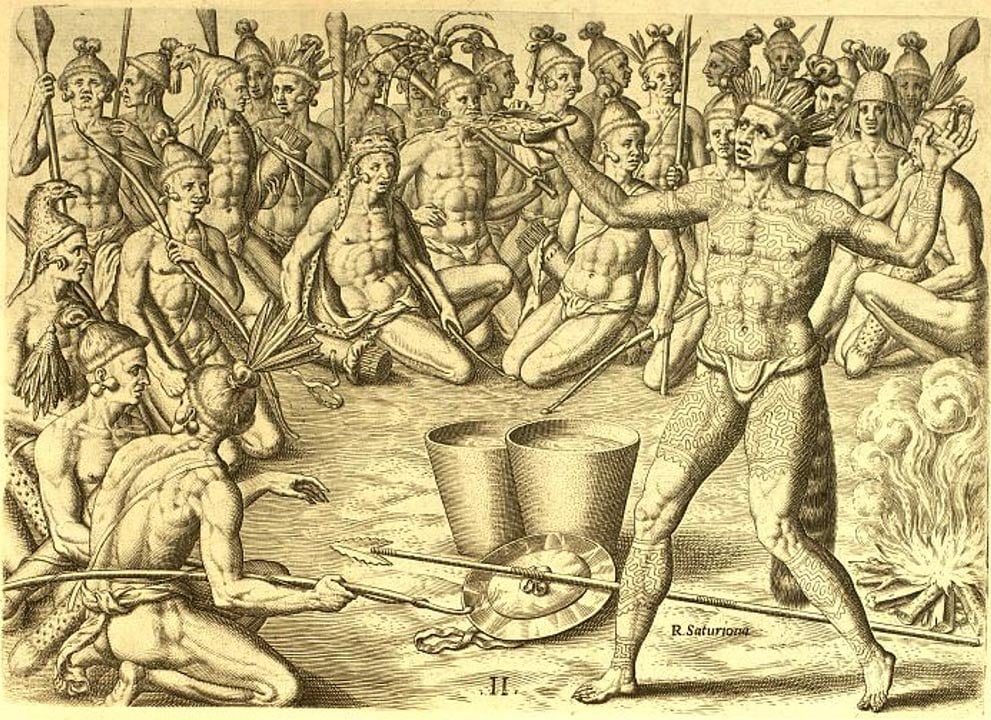People in the Southwestern United States drank caffeinated drinks in 750 AD
The sparse population inhabiting the area that is now the Southwestern United States and Northwestern Mexico during the eighth century AD regularly consumed drinks made from cacao—the plant that is used to make chocolate—and holly (Ilex), researchers from the University of New Mexico have discovered. Both these drinks were high in caffeine. The caffeine was consumed in two types of drinks. One was a cacao- (or cocoa)-based chocolate drink. The other was made from a particular species of holly, used to make what Native Americans in the southeastern U.S. called Black Drink.
“Black Drink was consumed throughout much of the southern US from Texas to Florida by Native American groups” said University of New Mexico Distinguished Professor of Anthropology and lead author Patricia Crown, “and it still is consumed in some parts of the south. It is prepared more like tea than like coffee - the leaves/twigs are toasted and then steeped. Younger leaves have more caffeine than older ones.”
The study conducted by the researchers is now the subject of a paper published in Proceedings of the National Academy of Sciences (PNAS) entitled “Ritual drinks in the pre-Hispanic U.S Southwest and Mexican Northwest”. It analyzes how widely caffeinated drinks were consumed at different time periods.
Neither cacao nor holly grows in the Southwest, so the plants must have been imported from elsewhere. However, the researchers are not yet completely sure what trade routes in the area may have been used for this purpose. According to Professor Crown, there must have been some trade with Mexico, because that is the closest place the people at the time could have sourced cacao from. Another indication of trade between the two areas is the presence of scarlet macaws, large South American parrots, at many Southwestern sites.
- The Ancient History of Chocolate, Gift of the Gods
- Ancient Monastery Recreates Beer Based on Historic Recipe by British Soldiers
- Archaeologist attempts to revive lost alcoholic beverages from ancient recipes and residues

The Holly/Ilex vomitoria plant, left (Public Domain) and toasted cacao beans, right (CC BY-SA 3.0) were used to make the traditional caffeinated Black Drink.
“I think the primary significance is that it shows that there was movement of two plants that have caffeine in North America – that they were either exchanged or acquired and consumed widely in the Southwest” said Professor Crown.
Holly could have been sourced from either what is now the Southern United States or from Mexico, but the residues found in ceramic bowls and sherds from pitchers are not sufficient to enable the scientists to find out more about the black drink these people consumed. Crown believes that caffeine was probably ingested as part of a ritual or in political contexts, as they were in Mesoamerica, but part of this theory is based purely on context.
“We believe that because the plants came from such a distance and would be difficult to acquire, they were more likely used in special contexts: rituals, feasts, perhaps politically motivated interactions” Crown said. “Those who had the ability to acquire these distant resources could build alliances and obligations by serving them. It seems unlikely that they were consumed casually - especially since they were considered special drinks in the areas where the plants were more readily available. We don't know how the drink ingredients came to the US Southwest/Mexican Northwest - people from those areas might have acquired them at the source or people from Mesoamerica (or the US Gulf Coast) could have brought them to trade to the southwestern culture area. Or there could have been down the line exchange from one area to the other.”

Engraving showing Eastern Woodland people of the United States making black drink in 1723. Public Domain
Figuring out the location and courses of these trade routes may not be possible, but the results of the study certainly confirm that people in the southwestern culture area had extensive knowledge of distant resources and the wherewithal to acquire them—through exchange. They also had social networks in place to get them regularly enough to use in special activities that were recurrent, such as rituals/feasts or other gatherings.
- Should Adult Humans Drink Milk? Study of Neolithic Farmers May Have the Answer
- The ancient origins of the ceremonial Kava drink of the Pacific
- A royal find of ancient grapes and wine residue may help resurrect Canaanite vinting
Professor Crown used sherds of pottery from cylinder jars in her research on the consumption of cacao in Chaco Canyon, New Mexico. One hundred and eleven such sherds were found in 1896 in one room of Pueblo Bonito but most of the cylinders are now kept in collections at the American Museum of Natural History.

Mesa Verde black-on-white mug (c) Crow Canyon Archaeological Center; BLM-Anasazi Heritage Center (97.10.5MT765.V100R9U553)
The new research used sherds from jars, bowls, and pitchers found at archaeological sites throughout the Southwest. It expands present understanding of the spatial extent of caffeinated drink use in North America.
In all, 177 sherds were tested and caffeine was found in 40 of the samples. Crown and her team also carefully selected sherds of pottery used at different time periods in order to get a better idea of whether the trade was conducted at isolated time periods or was fairly constant.

Fourmile Polychrome flowerpot-shaped vessel (Cat. No. A-28500) from Grasshopper Pueblo. Photograph by Patrick D. Lyons, courtesy of the Arizona State Museum, University of Arizona.
“We know it was (and is) extensive in South America - with many kinds of caffeinated plants used to make drinks consumed regularly (including several varieties of Holly) - and now we are getting a fuller picture of the use of caffeinated plants in North America” Professor Crown said.
The pre-Hispanic southwest was inhabited by many different groups of people belonging to different and distinct cultures. This research shows that one thing they had in common was a great liking for caffeine. This was so strong that for at least 700 years it was worth acquiring the plants from many miles away.
Just a thought when you’re next queuing at Starbucks.
Featured image: Chief Saturiwa prepares his men for battle during a ceremony involving the black drink. The Florida Center for Instructional Technology, University of South Florida/Public Domain




















Comments
There's typically 10 times as much theobromine as caffeine in cocoa and chocolate products. I inserted a link to a commercial site that gave chapter and verse, but comment got rejected by the spam filter. Site hanging up too, which I'll report to ChrisS tomorrow.
Cocoa contains some Caffeine as well as Theobromine.
Cabeza De Vaca, the Spanish explorer who traveled from Florida to Mexico in the
early 16th century described the ritualistic use of Ilex. The Indians would drink large
quantities of tea, then vomit it. They absorbed enough caffeine to keep them dancing
through the night.
Yes, there's a caffeine-like xanthine-based alkaloid in cocoa, chocolate etc called theobromine (though it was spelled theobromin when I was attending chemistry lectures some 50 years ago, and preferable in my view, given there's no bromine in the molecule).
It differs from caffeine only in the degree of methylation (-CH3 groups) and also has stimulant properties, as I can personally attest (daren't drink coffee or cocoa after 6pm !).
So, is caffeine found in cocoa... or is it xantheine? Not that it makes a lot of difference.. Xantheine, caffeine, nicotine are all similar and yet different... so which was it?